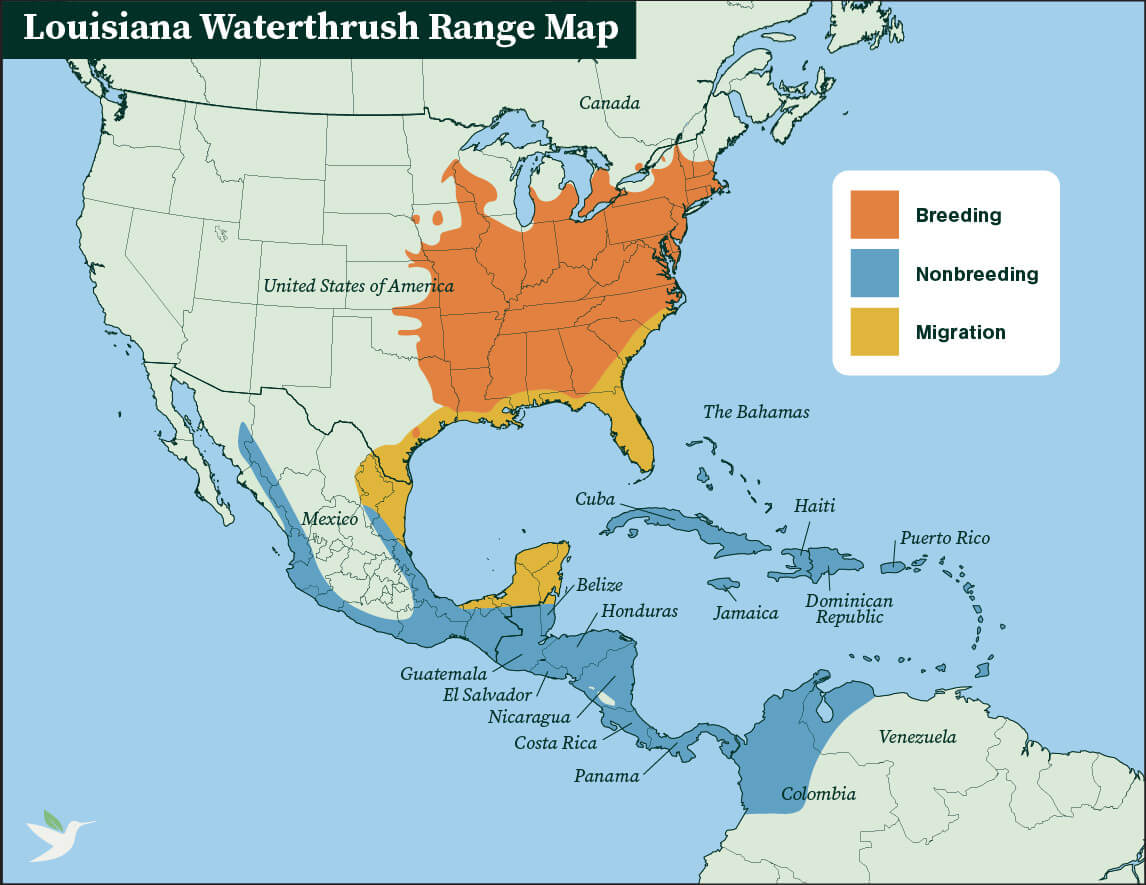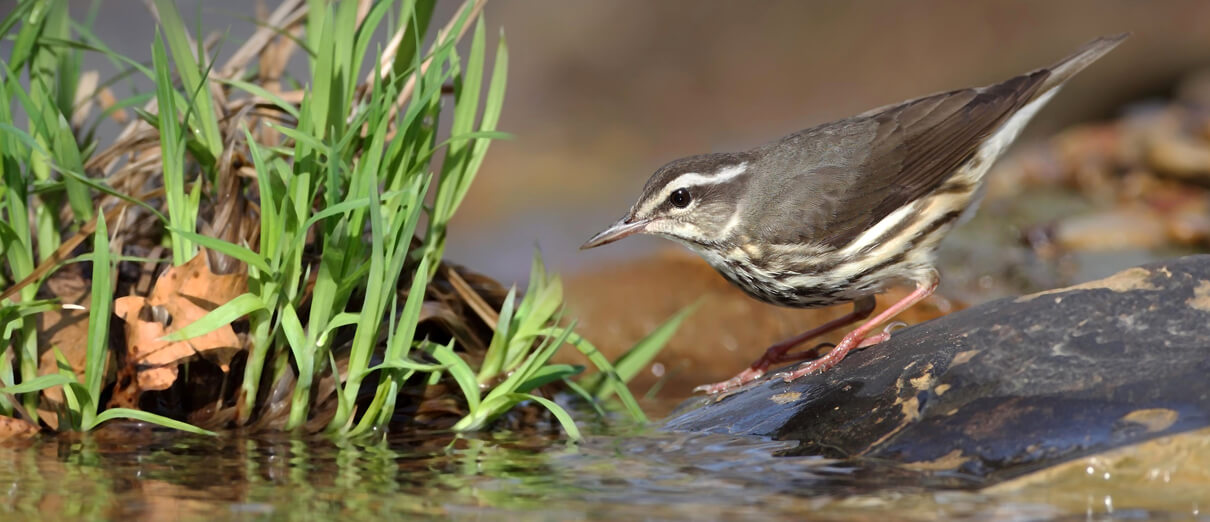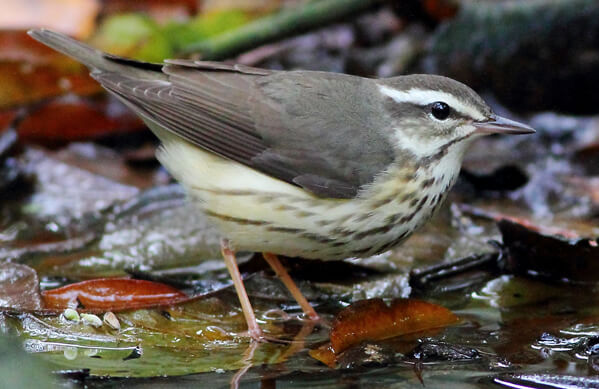
The ringing song of the Louisiana Waterthrush is a welcome sign of early spring throughout the eastern United States. This unlikely warbler, which is seldom seen or heard far from running water, can, at first glance, easily be mistaken for other brown-backed forest birds such as the Wood Thrush or Ovenbird.
But several distinctive habits make it easy to identify the Louisiana Waterthrush. It walks along muddy streambanks, unlike thrushes, which hop among leaf litter. And the waterthrush wags its tail and bobs its rear end up and down in a slow, teetering motion. This habit is so pronounced that it's recognized in the bird's species name, motacilla, which means "tail-wagger." This same name is also used in the unrelated genus Motacilla, a group of wagtails found in many parts of the world, including coastal Alaska.
Streambank Songbirds
Although they have a number of habits in common, the American Dipper is much more aquatic than the Louisiana Waterthrush. The dipper is the only North American songbird that routinely wades, swims, and even dives into cold mountain streams in pursuit of insect prey.
Unlike the Louisiana Waterthrush, the larger, rounder-bodied dipper only occurs in western mountains and its coloration is solid gray. But there is another waterthrush, the Northern, which looks very similar to the Louisiana. The two species' songs are very different (see below), plus there are subtle distinctions that an observer can parse out in the field. These include the Louisiana Waterthrush's bright pink legs, unmarked white throat, and the wide, white stripe above its eye, called a supercilium. Although both species can be seen in the same wet, treed areas during migration, for nesting, the Northern Waterthrush prefers quieter waters, such as bogs and swamps, and true to its name, this species nests farther north or at higher elevations in the northern Appalachians.

Early Arrivals
Each spring, the Louisiana Waterthrush is one of the earliest wood-warblers to arrive on its breeding grounds. It is also one of the first to depart after the nesting season winds down. The species' breeding range extends across most of the eastern United States, reaching far-southeastern Ontario, Canada, and it winters from Mexico to northwestern South America and the Caribbean. Like many warblers, it migrates at night.
The Louisiana Waterthrush's resounding song reminds a listener of cascading water: It begins with descending high-pitched notes, then falls into a jumble of short, hurried phrases. It is loud enough to carry long distances, and can be heard over the background noise of running water so characteristic of this bird's streamside habitat. Its call note, a loud, strong chink, is also distinctive.
Streamside Dining and Digs
The Louisiana Waterthrush forages by picking aquatic insects, crustaceans, snails, and worms from the water while walking along stream edges. It will also hover over the water to pick insects from the water's surface or from vegetation, and dash out from a perch to catch flying insects. It occasionally takes small frogs, salamanders, or fish as well.
While the Louisiana Waterthrush feeds close to forested streams during the breeding season, the species widens its foraging areas during migration and winter, when it can be seen along flooded roads or trails, impoundments, and even in suburban areas including parks, sodden lawns, and gardens.
Male Louisiana Waterthrushes arrive on the breeding grounds in early spring. Like the American Dipper, this species stakes out a linear stream drainage territory that can range from 1,230 to nearly 4,000 feet long. Neighboring males defend their turf by chasing and counter-singing; rival males also face off in flapping displays in which the birds quickly raise and lower their wings.
Louisiana Waterthrushes are usually monogamous during nesting, and sometimes remain with the same mate for several breeding seasons. Pairs typically produce one brood per nesting season.
Like the Kentucky and Kirtland's Warblers, the Louisiana Waterthrush is a ground-nester, favoring concealed spots in dense vegetation, rock crevices, and root tangles along the water's edge. Both parents gather suitable material — wet, muddy leaves, grass, rootlets, pine needles, and small twigs — and build their cup-shaped nest in a small concealed hollow, where the female lays four to six eggs, which she broods for several weeks. Both parents feed the young, even for several weeks after they leave the nest. The Louisiana Waterthrush, like many ground-nesting bird species, is a common host for the Brown-headed Cowbird, often raising cowbird chicks to the detriment of their own.
Double Dose of Vulnerability
Since the Louisiana Waterthrush depends upon clean water and forests in both breeding and wintering areas, the species is vulnerable to habitat loss caused by forest fragmentation and stream pollution. Forest fragmentation also makes this species more vulnerable to cowbird parasitism. As a long-distance migrant, the Louisiana Waterthrush also falls victim to collisions with tall buildings and communications towers.
ABC's Glass Collisions program is working to reduce threats to migrating Louisiana Waterthrushes. We have also collaborated with partners to preserve winter habitat for this species and other migrants at Guatemala's Tapon Creek Nature Reserve.
Last year, ABC and partners fitted ten Louisiana Waterthrushes and ten Wood Thrushes with nanotags (small radio transmitters) at the El Jaguar Reserve in northern Nicaragua. These tags transmit information on the birds' movements to a network of receiving stations — part of a larger effort to gather information that will help target conservation initiatives for the waterthrush and other declining long-distance migrants.
Initial analysis of spring and summer 2020 data showed that three of the waterthrushes were in the U.S. during migration and the breeding season, including one bird detected in Pennsylvania. These results show a likely connection between forests in the Appalachian Mountains Joint Venture and the Nicaragua Highlands, an ABC-declared BirdScape.
Donate to support ABC's conservation mission!



















































